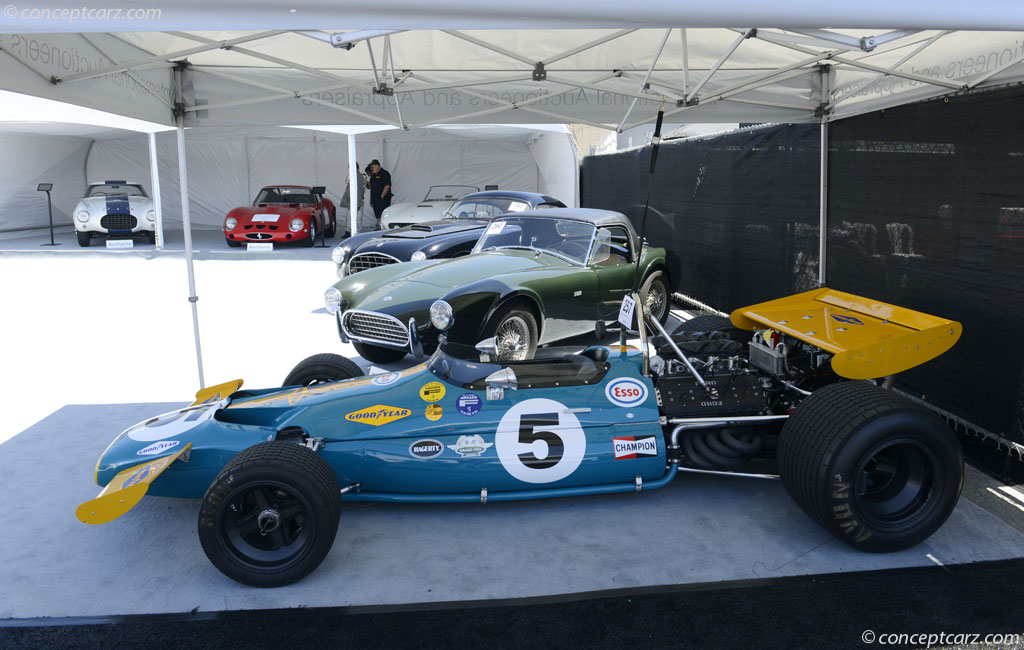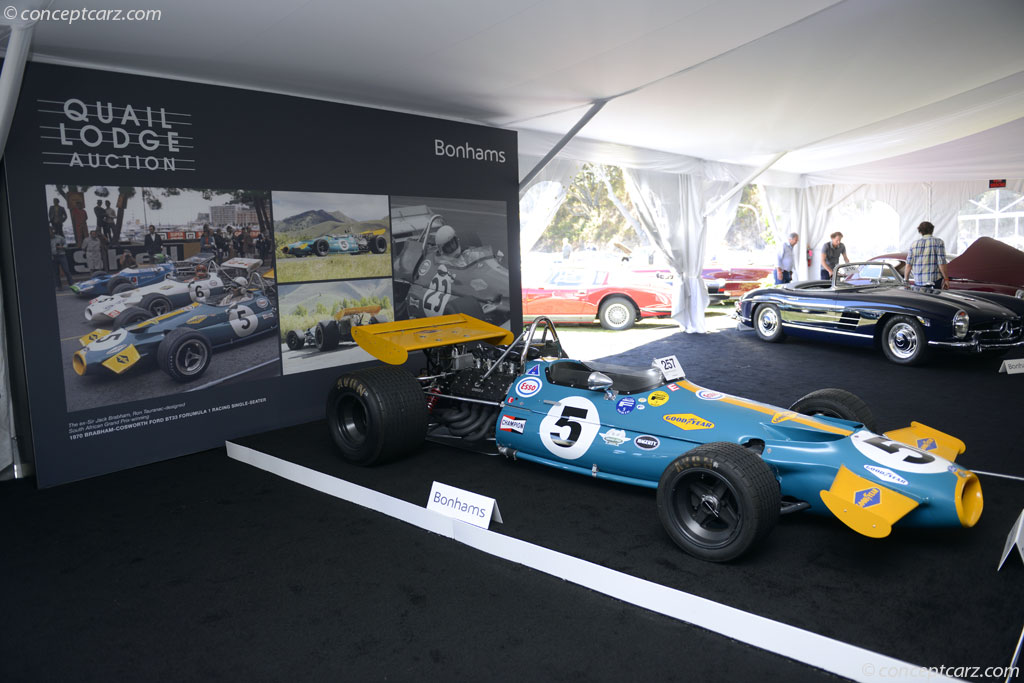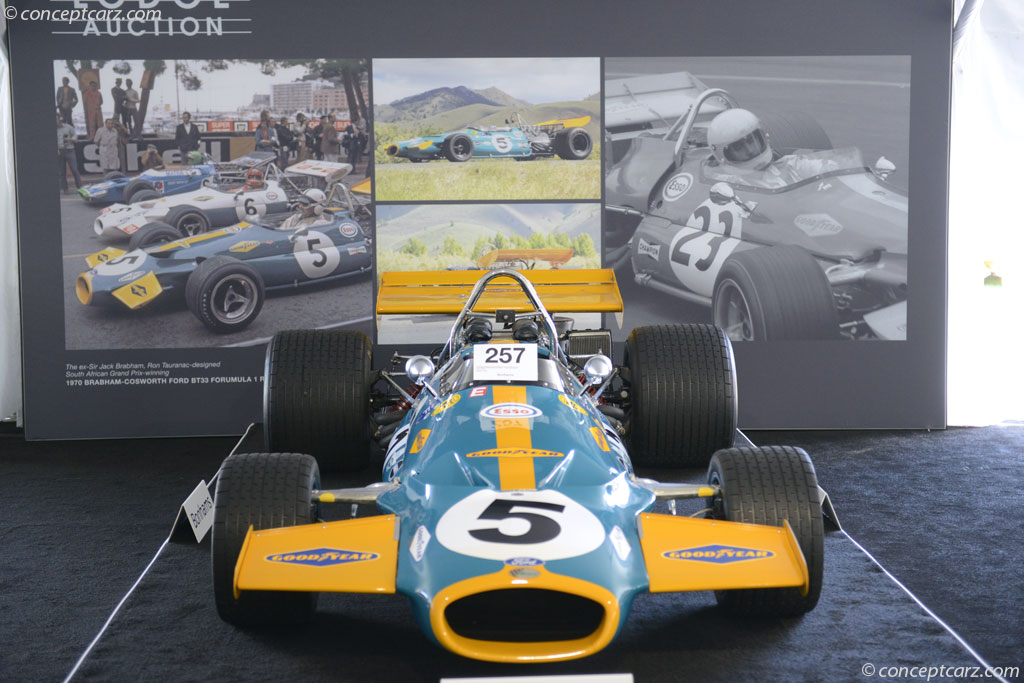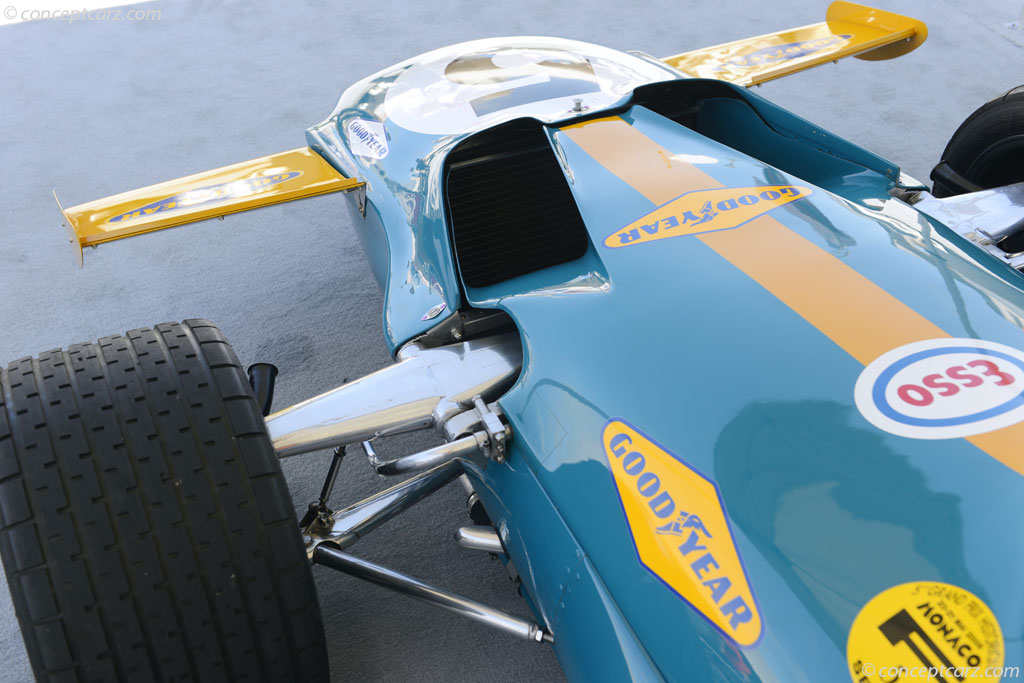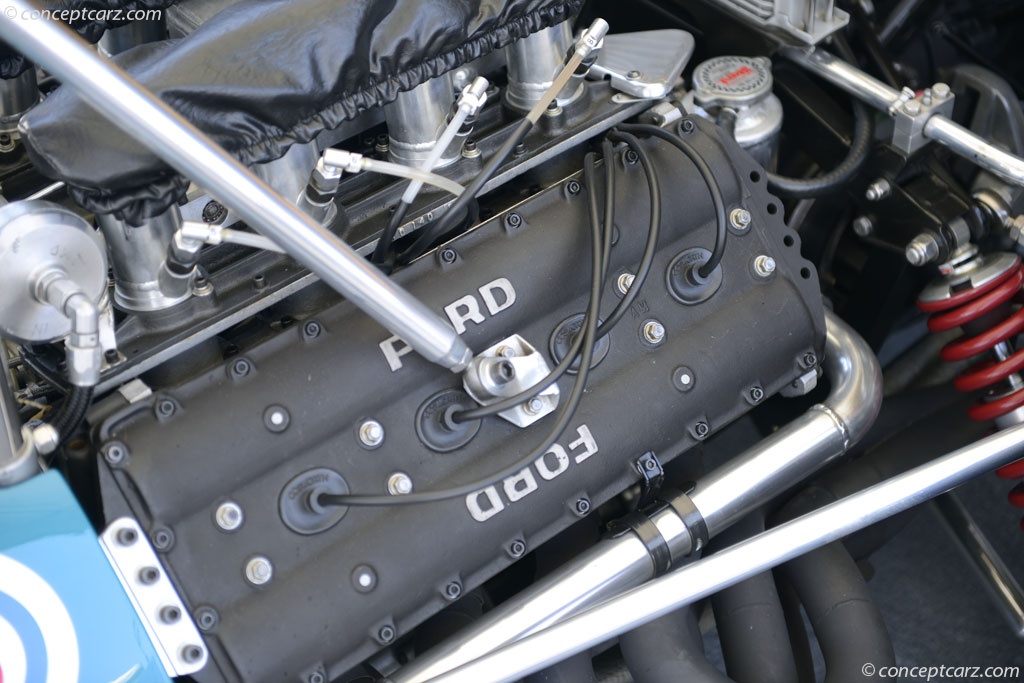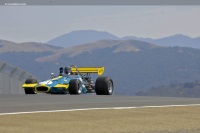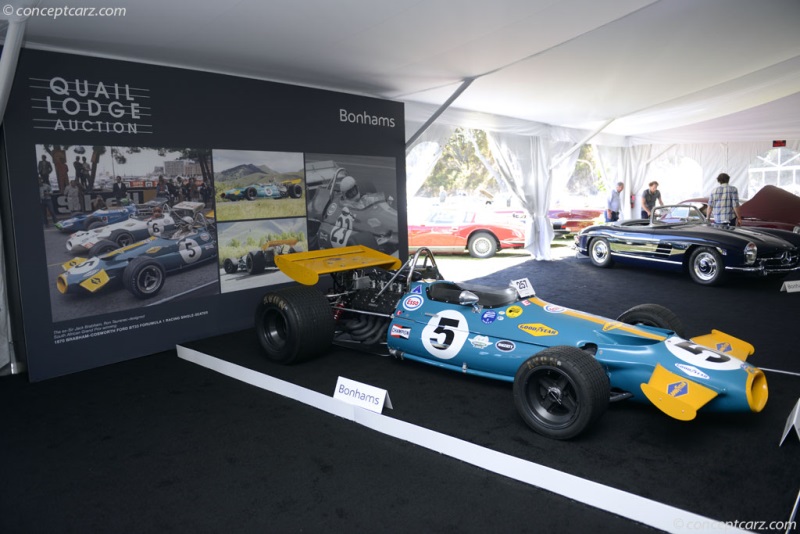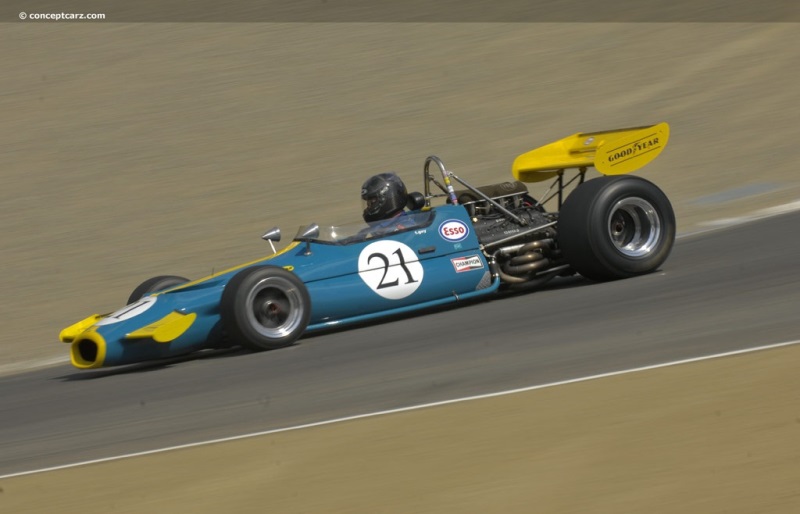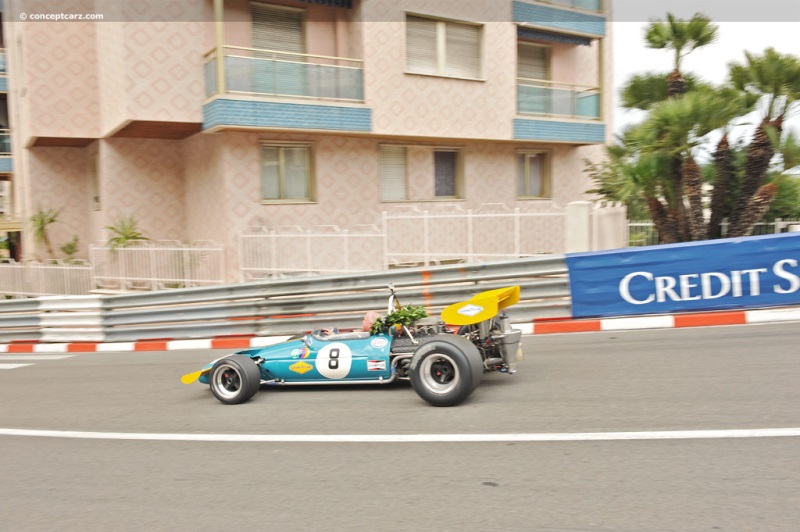Image credit: © conceptcarz.com (Reproduction Or reuse prohibited).
The suddenly switch in camera position and the split-second shot of a car plowing head-first into the guardrails on the outside of the Gazometre hairpin would almost seem surreal. What would be truly surreal would be the way that last second glimpse would be the way in which the championship was thoroughly wrenched from Jack Brabham's hands. It would serve as a stark contrast to the beginning of the season.
Brabham would become a two-time Formula One World Champion securing the title in back-to-back seasons. Driving for Cooper, Brabham would help lead the mid-engine revolution in Formula One and would sit alone at the top in 1959 and 1960.
Having an engineer's mind himself, Brabham would be drawn to the notion of designing and building cars to his own liking. He could see there were some around him at Cooper that could use a change. Therefore, the Australian would leave the team by which he came upon his World Championships and would form a new racing manufacturing company by the name of Motor Racing Developments Ltd.
Building cars with the 'Brabham' moniker, it wouldn't take Brabham and Ron Tauranac very long before they were building cars for Formula One. Of course, the aim would always be very simple: to win a race in a car of his own, and then, perhaps, the World Championship. But the Brabham name would extend well beyond Formula One. Besides building cars for the Formula Junior category, MRD would build cars for Formula 2, Formula 3 and even Indycar.
The team's first victory would come in 1964, just a matter of a couple of years after beginning. Dan Gurney would drive his Brabham to victory in the French Grand Prix giving Brabham his first real highlight as a car maker. Then, finally, in 1967, Brabham would finally achieve his first goal of taking victory in a car of his own. That historic moment would come at the French Grand Prix held in Reims in July of 1966. This would lead to a run of victories by the Aussie that would, ultimately, lead to the second goal, that of winning a World Championship in his own car, a reality as well.
The 1966 season would be a special one and would be followed up with a competitive 2nd place finish in the championship the following year. Then, in 1968, Brabham would supremely struggle finishing toward the bottom of the championship roster. It seemed the championship of '66 was not going to lead to a Formula One dynasty after all. In 1969, things would improve for Brabham, Jacky Ickx would finish 2nd in the championship in one of Brabham's cars, but Jack himself would only finish 10th in the standings.
But then came 1970. The 1970 season would actually start out with Brabham serving more of a substitution role than as a full-time driver. Suffering some terrible injuries in 1969, Brabham would actually retire from racing at the end of the '69 season. However, he would be unable to find a competitive replacement and would determine to drive one more season.
Jack had already sold his share of the team to Tauranac, and Ron would use his position of authority well designing an improvement for the BT26 chassis that would be used during the '69 season.
The team had switched from Repco power in 1969 to Cosworth. This had helped to turn around what had been a dismal period for the team. However, Tauranac and his team knew he needed more than just a competitive engine to turn things around fully. Keeping some proven elements, Ron would develop the first full monocoque chassis for Brabham. Combined with the Cosworth as a fully-stressed member of the chassis, the new BT33 looked similar to its predecessors but would be a marked improvement.
In total, there would be three examples of the BT33 built for the 1970 season. Chassis BT33-1, however, would not be for Jack as his decision to return to racing would be a rather late one. No, 'Black Jack' would be given the second chassis, BT33-2, and it would prove to be a match made in heaven, at least initially.
Heading into the first race of the season, the South African Grand Prix, there would be some elements of the car still being worked and fitted. One of those carrying out the work would be none other than Ron Dennis. Dennis' work, along with the rest of the crew's, would help the BT33 be competitive throughout practice and qualifying. However, during the early part of the race, Jack would be delayed and would end up well down in the order. No matter, Brabham would quickly march up through the order and would soon be pressuring Jackie Stewart for the lead. Having the pace of the Tyrrell well in hand, Jack was simply biding his time when he would get struck in the face with a rock kicked up from Stewart's car. This would delay the Aussie again, but, by the 20th lap, he would be in the lead and would never be challenged again by any other driver. Remarkably, in its very first race, BT33-2 would come home victorious and suddenly Brabham would seem refreshed and serious about mounting a charge for the championship.
Brabham would remain around the top of the championship standings when he, and BT33-2, arrived in Monaco for the famed race on the 10th of May. Jack would look strong starting from 4th place on the grid. Then, during the race, Jack would systematically move up the order passing Amon and then Stewart after the Tyrrell developed problems. Suddenly the 40 something Aussie was in the lead and in charge. BT33-2 was a new, a potent machine and it was feeding life to its namesake.
Brabham had been pulling away but was to come under pressure in the later-stages by the man he had intended to take his place within the team. Jochen Rindt had moved up to 2nd place and would be driving with abandoned in an effort to exert pressure on Jack. Still, it seemed, even as the two cars took off around the circuit on the final lap of the race, the Aussie would come through triumphant as Monaco was no easy place to pass. Everyone believed the race to be over. But then, as the television crews and everyone else looked back and forth between Brabham and Rindt, there would be this sudden, split-second shot of a car barreling into the guardrail at Gazometre. At the flag stand, awaiting the blue and yellow Brabham, the man holding the checkered flag would fail to notice the red and gold Lotus that passed by. What happened to Brabham? He should have come through by now. Then it began to set in…who won the race? Finally, Rindt would be waved down as the winner and Brabham's championship hopes would pretty much slide into the barriers right along with the lost win at Monaco.
In spite of the fact Brabham would only end up on the podium one more time over the course of the rest of the season there would be no doubt as to the potential of the Brabham BT33 and the fact it would play an important role in giving Jack even a shot at the title one last time.
Despite a crash at Zandvoort that left the car inverted in a ditch, BT33-2 would carry on through to the end of the season. The following year, the car that would give Brabham his last win in Formula One, would be bought by Alain de Cadenet. However, the car was not to sit in some collection. Instead, the car would be bought to give British driver Chris Craft a shot at Formula One.
After this adventure the car would be used for parts. De Cadenet would build a sportscar for Le Mans and would use much of BT33-2. All that would remain would be the chassis itself. They would be put aside and respectively stored.
The car would eventually pass to Dick Crosthwaite as payment for a bill de Cadenet owed. Being the owner of Crosthwaite & Gardner, a restoration and preparation company, Dick would take and restore BT33-2 to its former glory.
By 1998, the car would come into the hands of its current owner and would be proudly displayed all throughout the vintage racing world. It would be put on display, and, it would also take to the track, showing just what made it a race winner more than two decades earlier.
Within the historic racing scene, the Brabham BT33s continue to prove their stature within the Brabham legacy. And though BT33-2 would come up short over the course of the 1970 season, it would provide Black Jack the means to bow out with style.
Bonham's 2014 Quail Lodge auction would sport the 1970 Brabham-Cosworth Ford BT33-2 as one of its feature automobiles. When it made its appearance there would be no shortage of interested buyers. In the end, the car would sell for $1,034,000.By Jeremy McMullen
Brabham would become a two-time Formula One World Champion securing the title in back-to-back seasons. Driving for Cooper, Brabham would help lead the mid-engine revolution in Formula One and would sit alone at the top in 1959 and 1960.
Having an engineer's mind himself, Brabham would be drawn to the notion of designing and building cars to his own liking. He could see there were some around him at Cooper that could use a change. Therefore, the Australian would leave the team by which he came upon his World Championships and would form a new racing manufacturing company by the name of Motor Racing Developments Ltd.
Building cars with the 'Brabham' moniker, it wouldn't take Brabham and Ron Tauranac very long before they were building cars for Formula One. Of course, the aim would always be very simple: to win a race in a car of his own, and then, perhaps, the World Championship. But the Brabham name would extend well beyond Formula One. Besides building cars for the Formula Junior category, MRD would build cars for Formula 2, Formula 3 and even Indycar.
The team's first victory would come in 1964, just a matter of a couple of years after beginning. Dan Gurney would drive his Brabham to victory in the French Grand Prix giving Brabham his first real highlight as a car maker. Then, finally, in 1967, Brabham would finally achieve his first goal of taking victory in a car of his own. That historic moment would come at the French Grand Prix held in Reims in July of 1966. This would lead to a run of victories by the Aussie that would, ultimately, lead to the second goal, that of winning a World Championship in his own car, a reality as well.
The 1966 season would be a special one and would be followed up with a competitive 2nd place finish in the championship the following year. Then, in 1968, Brabham would supremely struggle finishing toward the bottom of the championship roster. It seemed the championship of '66 was not going to lead to a Formula One dynasty after all. In 1969, things would improve for Brabham, Jacky Ickx would finish 2nd in the championship in one of Brabham's cars, but Jack himself would only finish 10th in the standings.
But then came 1970. The 1970 season would actually start out with Brabham serving more of a substitution role than as a full-time driver. Suffering some terrible injuries in 1969, Brabham would actually retire from racing at the end of the '69 season. However, he would be unable to find a competitive replacement and would determine to drive one more season.
Jack had already sold his share of the team to Tauranac, and Ron would use his position of authority well designing an improvement for the BT26 chassis that would be used during the '69 season.
The team had switched from Repco power in 1969 to Cosworth. This had helped to turn around what had been a dismal period for the team. However, Tauranac and his team knew he needed more than just a competitive engine to turn things around fully. Keeping some proven elements, Ron would develop the first full monocoque chassis for Brabham. Combined with the Cosworth as a fully-stressed member of the chassis, the new BT33 looked similar to its predecessors but would be a marked improvement.
In total, there would be three examples of the BT33 built for the 1970 season. Chassis BT33-1, however, would not be for Jack as his decision to return to racing would be a rather late one. No, 'Black Jack' would be given the second chassis, BT33-2, and it would prove to be a match made in heaven, at least initially.
Heading into the first race of the season, the South African Grand Prix, there would be some elements of the car still being worked and fitted. One of those carrying out the work would be none other than Ron Dennis. Dennis' work, along with the rest of the crew's, would help the BT33 be competitive throughout practice and qualifying. However, during the early part of the race, Jack would be delayed and would end up well down in the order. No matter, Brabham would quickly march up through the order and would soon be pressuring Jackie Stewart for the lead. Having the pace of the Tyrrell well in hand, Jack was simply biding his time when he would get struck in the face with a rock kicked up from Stewart's car. This would delay the Aussie again, but, by the 20th lap, he would be in the lead and would never be challenged again by any other driver. Remarkably, in its very first race, BT33-2 would come home victorious and suddenly Brabham would seem refreshed and serious about mounting a charge for the championship.
Brabham would remain around the top of the championship standings when he, and BT33-2, arrived in Monaco for the famed race on the 10th of May. Jack would look strong starting from 4th place on the grid. Then, during the race, Jack would systematically move up the order passing Amon and then Stewart after the Tyrrell developed problems. Suddenly the 40 something Aussie was in the lead and in charge. BT33-2 was a new, a potent machine and it was feeding life to its namesake.
Brabham had been pulling away but was to come under pressure in the later-stages by the man he had intended to take his place within the team. Jochen Rindt had moved up to 2nd place and would be driving with abandoned in an effort to exert pressure on Jack. Still, it seemed, even as the two cars took off around the circuit on the final lap of the race, the Aussie would come through triumphant as Monaco was no easy place to pass. Everyone believed the race to be over. But then, as the television crews and everyone else looked back and forth between Brabham and Rindt, there would be this sudden, split-second shot of a car barreling into the guardrail at Gazometre. At the flag stand, awaiting the blue and yellow Brabham, the man holding the checkered flag would fail to notice the red and gold Lotus that passed by. What happened to Brabham? He should have come through by now. Then it began to set in…who won the race? Finally, Rindt would be waved down as the winner and Brabham's championship hopes would pretty much slide into the barriers right along with the lost win at Monaco.
In spite of the fact Brabham would only end up on the podium one more time over the course of the rest of the season there would be no doubt as to the potential of the Brabham BT33 and the fact it would play an important role in giving Jack even a shot at the title one last time.
Despite a crash at Zandvoort that left the car inverted in a ditch, BT33-2 would carry on through to the end of the season. The following year, the car that would give Brabham his last win in Formula One, would be bought by Alain de Cadenet. However, the car was not to sit in some collection. Instead, the car would be bought to give British driver Chris Craft a shot at Formula One.
After this adventure the car would be used for parts. De Cadenet would build a sportscar for Le Mans and would use much of BT33-2. All that would remain would be the chassis itself. They would be put aside and respectively stored.
The car would eventually pass to Dick Crosthwaite as payment for a bill de Cadenet owed. Being the owner of Crosthwaite & Gardner, a restoration and preparation company, Dick would take and restore BT33-2 to its former glory.
By 1998, the car would come into the hands of its current owner and would be proudly displayed all throughout the vintage racing world. It would be put on display, and, it would also take to the track, showing just what made it a race winner more than two decades earlier.
Within the historic racing scene, the Brabham BT33s continue to prove their stature within the Brabham legacy. And though BT33-2 would come up short over the course of the 1970 season, it would provide Black Jack the means to bow out with style.
Bonham's 2014 Quail Lodge auction would sport the 1970 Brabham-Cosworth Ford BT33-2 as one of its feature automobiles. When it made its appearance there would be no shortage of interested buyers. In the end, the car would sell for $1,034,000.By Jeremy McMullen
2014 Bonhams Quail Lodge Auction
Sale Price :
USD $1,034,000
Recent Sales of the Brabham BT33
(Data based on Model Year 1970 sales)
| 1970 BRABHAM-COSWORTH FORD BT33 FORMULA 1 RACING SINGLE-SEATER Chassis#: BT33-2 Sold for USD$1,034,000 2014 Bonhams Quail Lodge Auction |   |
Brabham BT33s That Failed To Sell At Auction
1970 Brabham BT33's that have appeared at auction but did not sell.
| Vehicle | Chassis | Event | High Bid | Est. Low | Est. High |
|---|
Vehicles With Comparable Market Values
Similar sales to the $1,034,000 range.
| 1969 Lamborghini Miura P400 S Coachwork by Bertone Chassis#:4124 Sold for $1,037,077 2024 Bonhams : Les Grandes Marques du Monde a Paris | |
| 2011 Ferrari 599 GTO Chassis#:ZFF70RCA0B0183377 Sold for $1,039,000 2023 RM Sothebys : Monterey |   |
| 1958 Mercedes-Benz 300 SL Roadster Chassis#:198.042.8500277 Sold for $1,040,093 2023 RM Sothebys : Villa Erba | |
| 1975 Lamborghini Countach LP400 Chassis#:1120018 Sold for $1,032,718 2023 Artcurial : Retromobile | |
| 2005 Porsche Carrera GT Chassis#:WP0CA29885L001160 Sold for $1,033,500 2023 Bonhams : Scottsdale Auction | |
| 2019 FORD GT Chassis#:2FAGP9CW1KH200162 Sold for $1,028,500 2022 Barrett-Jackson : Houston | |
| 1958 Mercedes-Benz 300SL Roadster Chassis#:198.042.7500570 Sold for $1,039,000 2022 Bonhams : The Quail Auction | |
| 1959 Maserati 3500 GT Spyder Prototype by Vignale Chassis#:AM101.678 Sold for $1,025,000 2022 RM Sothebys : Monterey |   |
| 2017 Ford GT Chassis#:2FAGP9CW7HH200109 Sold for $1,025,000 2022 RM Sothebys : Sand Lots | |
| 1958 Mercedes-Benz 300 SL Roadster Chassis#:198.042.8500137 Sold for $1,035,821 2022 RM Sothebys : Paris | |
| 1975 Lamborghini Countach LP400 'Periscopio' by Bertone Chassis#:1120110 Sold for $1,024,086 2021 RM Sothebys : The Guikas Collection | |
| 1961 Mercedes-Benz 300 SL Roadster Chassis#:198.042.10.002899 Sold for $1,043,753 2021 RM Sothebys : St. Moritz, Switzerland | |
| 1964 Porsche 356 C Carrera 2 Cabriolet Chassis#:160790 Sold for $1,039,000 2021 Gooding & Company : Pebble Beach Concours Auction |  |
| 2019 McLaren Senna Chassis#:SBM15ACA4KW800095 Sold for $1,044,000 2021 RM Sothebys : Arizona | |
| 1958 Mercedes-Benz 300 SL Roadster Chassis#:198.042.8500284 Sold for $1,028,000 2020 Bonhams : Amelia Island Concours | |
| 1963 Aston Martin DB4 Chassis#:DB4C/1092/R Sold for $1,032,584 2019 Bonhams : Aston Martin Sale | |
| 1957 Mercedes-Benz 300 SL Roadster Chassis#:198.042.7500547 Sold for $1,026,603 2019 RM Sothebys : Paris | |
| 1988 PORSCHE 959 COMFORT Sold for $1,040,009 2018 Coys - Blenheim Palace | |
| 2006 Ferrari 575 Superamerica Chassis#:ZFFGT61B000146050 Sold for $1,027,245 2018 RM Sothebys : Monaco | |
| 1957 Mercedes-Benz 300 SL Roadster Chassis#:198.042.7500180 Sold for $1,034,000 2017 Gooding & Company : Pebble Beach |
1970 Brabham BT33
• Additional valuation insight and sales data• History
• Specifications
• Image gallery
• Other Brabham BT33 model years
